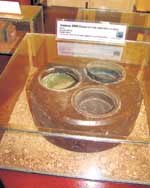| Colombo
sees horror of landmines
By Kumudini Hettarachchi
A young mother tenderly runs her fingers
over the face of her toddler and gently feeds a ball
of rice to him. It is motherly love of the highest kind,
for this woman is blind. She was not born blind nor
has she been blinded by illness. She has lost her precious
sight because of man’s cruelty to man. She is
the victim of an anti-personnel mine, not in Cambodia
or in Afghanistan, but right here in Sri Lanka, up in
the north. The searing images of this woman, abandoned
by her husband after she lost her sight, along with
another man and a woman who have both lost one of their
legs to landmines, shown in Colombo last Wednesday told
the tragic story not only of the bloody violence that
has dogged this country for nearly 25 years but also
of the scourge that landmines have posed to men, women
and children, the innocent players in a deadly arena.
 |
| A dummy wearing a de-mining kit
Pix by Berty Mendis |
These images brought the harsh reality
of landmines, mainly confined to 730 villages in the
north and the east, to the hall of the Lakshman Kadirgamar
Institute of International Relations & Strategic
Studies in Colombo 7, at a function held to mark the
release of the ‘Landmine Monitor Report 2006 –
Toward a Mine-Free World’, concurrently with the
global release in Geneva, Switzerland.
And the Landmine Monitor Report –
with a separate section on Sri Lanka -- reveals that
the Sri Lankan government has estimated that a million
landmines were laid in the country by both sides (the
other being the LTTE), while the LTTE quotes double
that number.
Urging that the assurance of the future
disuse of landmines is a must, Ambassador Satnam Jit
Singh of the International Campaign to Ban Landmines
(ICBL) said they called for a commitment from both sides.
With the setback in the peace process, there were unconfirmed
reports of the re-use of anti-personnel mines, he said.
The ICBL appealed to the Sri Lankan
government to show courage and take a bold decision
on humanitarian grounds to support the treaty for a
world-free of landmines, he said explaining that innocent
citizens were the sufferers. Such a decision would lead
to international pressure on the other side.
Adding a strong voice to the request
to the Sri Lankan government to ratify the Mine Ban
Treaty, British High Commissioner Dominick Chilcott
said since almost all the landmines have been laid in
the north and the east of the country, it is the people
who live there who stand to benefit the most from the
removal of landmines. “The Sri Lankan army deserves
credit for its contribution to date in removing landmines,
as do the other de-mining organizations working here.
But the administration could do more. It would be a
hugely significant gesture to those communities in the
north and the east to hear that the government had definitively
decided to give up using landmines and that it was going
to make this commitment legally binding on itself through
becoming a party to the Ottawa Treaty. Doing this now,
at a time when tensions are high and when fighting has
intensified, would send a particularly strong signal
to people in the north and the east,” he said.
“In December 2005, Sri Lanka
commendably voted for the universalization of the Mine
Ban Treaty. The government’s heart is therefore
very much in the right place on this question. I would
encourage them not to wait for the LTTE but to have
the courage of their convictions and act now.”
 |
| Amman 2000 plastic circular anti-vehicle
mine |
Mr. Chilcott urged that laying of new
mines must be avoided. “There are reports that
anti-personnel mines have been redeployed in the recent
fighting. If true, this would be a serious setback to
the progress being made to clear mine-contaminated areas
and allow the land to be used productively for the good
of local communities. And secondly, the government,
to its credit, became a party to the Convention on Conventional
Weapons in September 2004. That convention imposes conditions
on the ways landmines can be used, which includes measures
such as putting a perimeter fence around mine fields
and keeping civilians away.”
Detailing Sri Lanka’s move towards
a mine-free land, well-known former civil servant Bradman
Weerakoon said the government action on banning mines
was contained in a promise at the UN in the General
Assembly speech of the Prime Minister in 2002. The LTTE
was going to reciprocate by signing the Geneva Call’s
Deed of Commitment, renouncing anti-personnel mines,
which was the only signal available to non-state actors.
Why should Sri Lanka join in the Mine
Ban Treaty, asked Mr. Weerakoon, adding that the government
may finally do so – and the lead must be taken
by the government, but obviously it would be only if
the other side also undertakes to do so, and stays by
its promise. “This is a very challenging question
made more difficult since today the country is virtually
at war with the security forces and the LTTE in armed
conflict.”
The Landmine Monitor is a civil society
initiative established in 1998 by the International
Campaign to Ban Landmines (ICBL) to monitor and report
on the implementation of an international disarmament
or humanitarian law treaty (the Ottawa Convention).
It contains information on landmine use, production,
trade, stockpiling, de-mining, casualties and victim
assistance in 126 countries and areas.
The Landmine Ban Advocacy Forum in
Sri Lanka formed under the auspices of the Consortium
of Humanitarian Agencies (CHA) in October 2003, comprises
representatives of the donor community, mine action
agencies, humanitarian agencies, with the Sri Lanka
Army as observers.
Landmine menace in Sri Lanka
according to the Landmine Monitor Report 2006
* At least 14 had been injured
by landmines/unexploded ordnance between January
and May 2006.
• 38 new casualties including
five deaths had been recorded by UNDP in 2005.
Among the casualties had been seven women and
nine children. This figure, however, is a significant
reduction from the 56 casualties (17 killed) recorded
in 2004.
• 1,282 civilian casualties
-- including 190 women and 253 children -- have
been recorded from 1985 to December 2005. Of these
casualties, 190 people had been killed and 1,092
injured. The Jaffna peninsula, with 678 casualties,
represented 53% of all casualties in Sri Lanka.
|
Sri Lanka to ratify Mine Treaty
soon?
Conceding that Sri Lanka has
not ratified the Mine Ban Treaty, unlike 151 other
countries, the Chairman of the National Steering
Committee for Mine Action M.S. Jayasinghe, also
Secretary to the Ministry of Nation Building,
said the country would do so soon.
When questioned whether he could
give a time frame, he said such ratification would
depend on the situation. When the peace process
commences, the government may sign the treaty,
he added.
|
|
